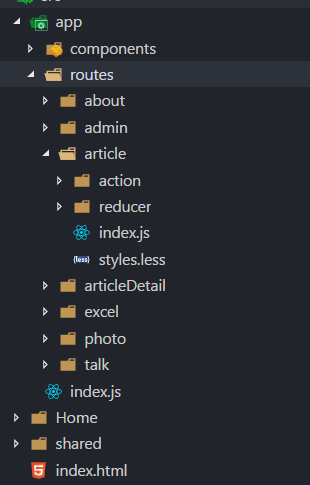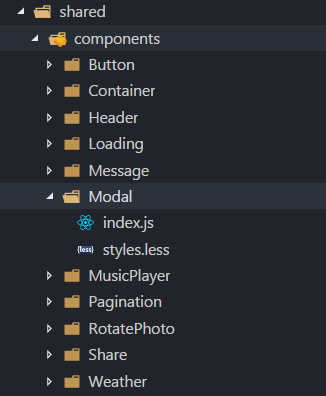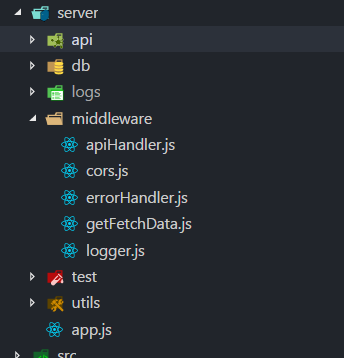1. 前言
曾几何时,躲在角落瑟瑟发抖的我,看着那些大佬们一个个的都有自己的个人网站,博客,我也心痒痒啊,于是下定决心,准备自己搞一个博客或者个人网站,时光匆匆流逝,键盘噼里啪啦,于是,你看到了现在这个样子的个人网站 《李金珂的小屋》 https://www.lijinke.cn
(现在已经变成了 hexo 的模板搭建的,以前的用的阿里云服务器 已经到期没续费了)
2. 前期准备
要搞个人网站,用什么技术栈
- jekyll
- github pages
- coding pages
- work
- hexo
太多太多了,但没得啥子特色,虽然方便快捷 但是千篇一律,思来想去
还是自己从 0 开始写吧,但是正在学习 React 和 Node.js, 于是前端使用 react 的 全家桶,后端使用 nodejs + mongodb. 功能模块有 聊天,看照片,博文,和自己的介绍
3. 前端部分
3.1 布局篇
项目架构 在 之前 架构师 seth 的基础上 改了一些,很快就跑起来了,下面就开始写页面了,因为是 react 和 redux 每个路由 都是长这个样子的,每个路由对应自己的 action 和 reducer. index.js 就是对应的页面,styles.less 是它当前的样式。比较好维护

当时放弃了 ie 的支持。由于是响应式的,所以 pc 和 mobile ui 下 都用的 flex 布局,比如下面这段 css, 很简单快捷的就实现了 pc 时 并排显示,mobile 时 纵向排列 , 其他没什么讲的,都是很简单的一些样式
1 | //全站配色定义 |
1 | @import "~styles/vars.less"; |
响应式方面就简单的处理了下,差不多都长这样
1 | .jinke-modal{ |
动画差不多都是这样子
1 | @keyframes publicTranslateXAnimate{ |
关于我们使用了一点 3d 的动画,朋友都说眼睛看着疼。..
1 | @keyframes aboutItemAnimate{ |
3.2 组件篇
既然是 React, 必然离不开组件,由于网站的性质比较简单,用不到什么复杂的组件,大概就分了下面这些组件

顾名思义,都是一些常规的组件,样式方面 后来 偷看了下 antd 的样式 把它改的 扁平化了一些,更好看了
<Loading/> 就是 页面加载中 显示的那个 全屏的原谅色 李金珂 三个字 svg 的效果 <Weather/> 就是简单的一个 canvas 的下雨
其他唯一有说的意义的是 <Message/> 组件 , 但是 React 16 还没有发布。也没有 传送门 的概念,
当时就在想怎么 做到和 antd 一样 可以 message.success() 这种快速的调用呢?后面通过观察,查资料,知道了大概的做法
首先在 root 节点 挂载一个 容器
1 | //Root.js |
以前只知道 static 的 属性 不会被继承,但是还有一个作用,即 在外部调用的时 可直接使用这个方
法,也就是 Message.error(), 调用之后 再调用 renderElement 就可以把节点挂载在我们之前设置的节点上了,
网上说的 this.ref.xx 的方法 实在难用至极,对应的如果卸载,即调用 ReactDOM.unmountComponentAtNode() 即可
1 | /** |
另外网站上用的音乐播放器 <MusicPlayer/> 就是 调用 audio 一些 api 操作,发布到了 npm 可独立使用地址 https://github.com/lijinke666/react-music-player
最后使用了 四个第三方的 组件 react-markdown , rc-calendar , share.js, socket-io-clent 分别用在了 文章详情的 渲染 , 文章列表页的搜索 和 分享,聊天。组件的质量和方便程度都不错,伟大的 github 啊 :)
3.4 Redux
页面写的差不多了,就要和 后端交互 拿数据 , 这里用的是 react-redux ,mbox 和 soga 以后会尝试,
刚开始 学习 redux 的时候觉得好复杂,dispatch action , 然后 又是啥子 reducer, 后面入门了之后发现也就那么回事,store 就基本上是个 全局变量,每个路由 基本 都张这个样子
使用 es7 装饰器 connect 组件
1 | import { connect } from 'react-redux'; |
connect 之后 在 props 里面 就拿得到 this.props.getArticleLists 这个方法,然后在挂载周期的时候 调用即可逻辑清晰易维护,但是写起来确实有一点繁琐,所以会出现 avd 之类的解决方案
action
1 | import helper from 'libs/helper'; |
reducer
1 | import { ARTICLE_LIST } from '../action'; |
后续的页面都是雷同,依葫芦画瓢,三下五除二就解决了。.. 接下来就是后端了
4. 后端部分
4.1 后端搭建
目录结构大致长这样,使用了我自己比较熟悉的 express, 其实个人认为 在 es7 async await nodejs 原生支持,koa(1|2) 其实也没什么优势了

- api 提供网站需要的一些接口
- middleware 提供需要的一些中间键
- apiHandler 包装结果,发送到前端
- errorHandler 包装错误信息,发送到前端
- getFetchData express 的 body-parser 模块 解析不了 fetch 传过来的 body. 所有手动接受
- logger 常规的一些日志输出 (log4js)
- test 单元测试 推荐一个 power-assets 比较好用
- utils 一些常用的工具函数
1 | //apiHandler.js |
1 | //errorHandler.js |
1 | //getFetchData.js |
这里如果需要避免 编码不是 utf8 导致 乱码 还应该 用 buffer 转一下。但是在此场景下不需要
其他就和平常了。没什么需要讲的,点赞 , 评论,发布文章,基本都是些 mongodb 的 find() update() create()
文章 api 设计的 人人可以发布文章。所有加了一个需要审核。然后邮件通知审核通过,最后显示在前端上。这里用到了 nodemailer 模块
后端大致依赖的模块
1 | const express = require('express'); |
HTTPS_CONFIG 之前申请了一个阿里云的免费 1 年 https 证书。后来去掉了。对这个网站来言。意义不大
5. 项目部署
经过 无数个周末 和空闲时间 网站的开发基本接近尾声了,接下来就是我比较陌生的一个环境了,也就是项目部署上线由于是前后端分离 所以我在 webpack 打包的时候 做了一下 测试环境 和 生产环境的区分,大致用到的 npm scripts 如下
1 | { |
然后在 webpack.config.js
1 | module.exports = (env) => { |
这样 在 public 的 static 就是我们的打包后的前端文件了,之后 设置 express 的静态地址为它即可
1 | app.use(express.static(`${__dirname}/../public`)); //设置静态资源目录 |
最后 运行一下这个命令 打包完成之后然后启动 node 服务 项目就跑起来
1 | npm run prod-server |
虽然在本地流程已经搞定了 但是在服务器上又是另外一码事,买域名,租云服务器,导入数据库,装 git. 这些 没接触的时候觉得没啥,真的自己整的时候 头皮发麻。各种问题都来了。还在 在朋友的帮助下一一都解决了,
印象比较深刻的是 服务器上 mongod --dbpath ./xxx 启动之后 就关机了 发现数据没了,后来才知道 mongodb 服务器掉了 , 后面才知道 要加一个 fork 让他以守护进程的方式,才行
同理,启动 node 服务也是如此,平时都是 node xx.js . 但是在服务器上也是需要 守护进程的方式 启动,
于是 使用了 pm2 这个开源模块,它使用了 集群 等原生 node 模块 实现了负载均衡,宕机重启,进程守护,超级好用,如果自己实现一个 简单的守护进程?后面学习了一下,没我想得那么难,大致就是 开一个 process 然后用这个 process 启动一个 子进程,执行 setsid 然后杀死这个 process 然后这个 子进程就是守护进程了
1 | //https://cnodejs.org/topic/57adfadf476898b472247eac |
最后经过一系列坑 和 不熟悉导致的 低级问题。反反复复的调试,网站终于上线了 !!!
6. 结语
–
一个人搞定一个网站说容易也容易,说难也难容易在 不想懂细节,懂实现,模板一套,插件一用,ctrl+cv 分分钟搞定难在 从无到有 的 每一个细节,原理,调试 bug 的头皮发麻,调通 bug 的独自窃喜,实现一个功能的膨胀炫耀难在 周末空余 深夜撸码的 疲倦与兴奋难在 键盘按下弹起 却无他人听到 用心做的东西却无人分享
有时反思自己,仿佛对什么也不在意,对什么也提不起兴趣,吉他也越练越少,笑容也越来越少每天疲倦的 上班下班 却不知道为什么疲倦,除了写代码,打游戏 好像 也没有什么能让我兴奋的东西我真他妈的可悲
